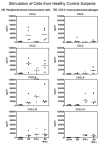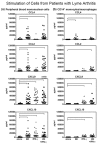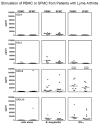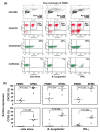Borrelia burgdorferi stimulation of chemokine secretion by cells of monocyte lineage in patients with Lyme arthritis
- PMID: 20828409
- PMCID: PMC2990995
- DOI: 10.1186/ar3128
Borrelia burgdorferi stimulation of chemokine secretion by cells of monocyte lineage in patients with Lyme arthritis
Abstract
Introduction: Joint fluid in patients with Lyme arthritis often contains high levels of CCL4 and CCL2, which are chemoattractants for monocytes and some T cells, and CXCL9 and CXCL10, which are chemoattractants for CD4+ and CD8+ T effector cells. These chemokines are produced primarily by cells of monocyte lineage in TH1-type immune responses. Our goal was to begin to learn how infection with Borrelia burgdorferi leads to the secretion of these chemokines, using patient cell samples. We hypothesized that B. burgdorferi stimulates chemokine secretion from monocytes/macrophages in multiple ways, thereby linking innate and adaptive immune responses.
Methods: Peripheral blood mononuclear cells (PBMC) from 24 Lyme arthritis patients were stimulated with B. burgdorferi, interferon (IFN)-γ, or both, and the levels of CCL4, CCL2, CXCL9 and CXCL10 were measured in culture supernatants. CD14+ monocytes/macrophages from PBMC and synovial fluid mononuclear cells (SFMC) were stimulated in the same way, using available samples. CXCR3, the receptor for CXCL9 and CXCL10, and CCR5, the receptor for CCL4, were assessed on T cells from PBMC and SFMC.
Results: In patients with Lyme arthritis, B. burgdorferi but not IFN-γ induced PBMC to secrete CCL4 and CCL2, and B. burgdorferi and IFN-γ each stimulated the production of CXCL9 and CXCL10. However, with the CD14+ cell fraction, B. burgdorferi alone stimulated the secretion of CCL4; B. burgdorferi and IFN-γ together induced CCL2 secretion, and IFN-γ alone stimulated the secretion of CXCL9 and CXCL10. The percentage of T cells expressing CXCR3 or CCR5 was significantly greater in SFMC than PBMC, confirming that TH1 effector cells were recruited to inflamed joints. However, when stimulated with B. burgdorferi or IFN-γ, SFMC and PBMC responded similarly.
Conclusions: B. burgdorferi stimulates PBMC or CD14+ monocytes/macrophages directly to secrete CCL4, but spirochetal stimulation of other intermediate cells, which are present in PBMC, is required to induce CD14+ cells to secrete CCL2, CXCL9 and CXCL10. We conclude that B. burgdorferi stimulates monocytes/macrophages directly and indirectly to guide innate and adaptive immune responses in patients with Lyme arthritis.
Figures




Similar articles
-
Borrelia burgdorferi RST1 (OspC type A) genotype is associated with greater inflammation and more severe Lyme disease.Am J Pathol. 2011 Jun;178(6):2726-39. doi: 10.1016/j.ajpath.2011.02.018. Am J Pathol. 2011. PMID: 21641395 Free PMC article.
-
Association of a Toll-like receptor 1 polymorphism with heightened Th1 inflammatory responses and antibiotic-refractory Lyme arthritis.Arthritis Rheum. 2012 May;64(5):1497-507. doi: 10.1002/art.34383. Arthritis Rheum. 2012. PMID: 22246581 Free PMC article.
-
High levels of inflammatory chemokines and cytokines in joint fluid and synovial tissue throughout the course of antibiotic-refractory lyme arthritis.Arthritis Rheum. 2007 Apr;56(4):1325-35. doi: 10.1002/art.22441. Arthritis Rheum. 2007. PMID: 17393419
-
Interferon-γ-induced protein 10 in Lyme disease.Clin Ter. 2017 Mar-Apr;168(2):e146-e150. doi: 10.7417/CT.2017.1997. Clin Ter. 2017. PMID: 28383628 Review.
-
Chemokine (C-X-C motif) ligand (CXCL)10 in autoimmune diseases.Autoimmun Rev. 2014 Mar;13(3):272-80. doi: 10.1016/j.autrev.2013.10.010. Epub 2013 Nov 2. Autoimmun Rev. 2014. PMID: 24189283 Review.
Cited by
-
Borrelia burgdorferi basic membrane protein A stimulates murine macrophage to secrete specific chemokines.Int J Med Sci. 2018 Oct 2;15(13):1473-1479. doi: 10.7150/ijms.26657. eCollection 2018. Int J Med Sci. 2018. PMID: 30443168 Free PMC article.
-
T-Helper 17 Cell Cytokine Responses in Lyme Disease Correlate With Borrelia burgdorferi Antibodies During Early Infection and With Autoantibodies Late in the Illness in Patients With Antibiotic-Refractory Lyme Arthritis.Clin Infect Dis. 2017 Apr 1;64(7):930-938. doi: 10.1093/cid/cix002. Clin Infect Dis. 2017. PMID: 28077518 Free PMC article.
-
Macrophage mediated recognition and clearance of Borrelia burgdorferi elicits MyD88-dependent and -independent phagosomal signals that contribute to phagocytosis and inflammation.BMC Immunol. 2021 May 17;22(1):32. doi: 10.1186/s12865-021-00418-8. BMC Immunol. 2021. PMID: 34000990 Free PMC article.
-
Different patterns of expression and of IL-10 modulation of inflammatory mediators from macrophages of Lyme disease-resistant and -susceptible mice.PLoS One. 2012;7(9):e43860. doi: 10.1371/journal.pone.0043860. Epub 2012 Sep 14. PLoS One. 2012. PMID: 23024745 Free PMC article.
-
Assessment of transcriptional activity of Borrelia burgdorferi and host cytokine genes during early and late infection in a mouse model.Vector Borne Zoonotic Dis. 2013 Oct;13(10):694-711. doi: 10.1089/vbz.2012.1189. Epub 2013 Aug 9. Vector Borne Zoonotic Dis. 2013. PMID: 23930938 Free PMC article.
References
-
- Steere AC, Schoen RT, Taylor E. The clinical evolution of Lyme arthritis. Ann Intern Med. 1987;107:725–731. - PubMed
-
- Mullegger RR, Means TK, Shin JJ, Lee M, Jones KL, Glickstein LJ, Luster AD, Steere AC. Chemokine signatures in the skin disorders of Lyme borreliosis in Europe: predominance of CXCL9 and CXCL10 in erythema migrans and acrodermatitis and CXCL13 in lymphocytoma. Infect Immun. 2007;75:4621–4628. doi: 10.1128/IAI.00263-07. - DOI - PMC - PubMed
Publication types
MeSH terms
Substances
Grants and funding
LinkOut - more resources
Full Text Sources
Medical
Research Materials

